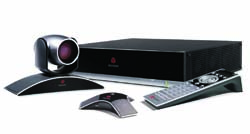- PLEASANTON, CA-This month Polycom releases a range of solutions to create a complete high definition videoconferencing experience. Polycom began delivering components based on its total HD communications and collaboration architecture solution, UltimateHD, last year with the Polycom MGC/MGC+, multipoint bridges that support true high definition and are capable of scaling to support 90 concurrent high-definition sessions.
Polycom's HD videoconferencing solutions
Enhancements have been made to the bridges for the MGC/MGC+ Release 8, including expanded on-demand conferencing capabilities, easier conference initiation and access from inside and outside the organization, simpler and more efficient use of videoconferencing for users, reduced management requirements for system administrators, and enhanced security for government networks with FIPS 140-2.
"If you want to do high definition properly, it requires all the other parts and pieces," said Paul Depperschmidt, Polycom's director of AV channels. "If you're going to truly do a good high-definition call, you need to make sure you have the ability to do a bridge call, for instance, so that if you wanted to do multipoint, your bridge needs to be able to handle the high-definition. As we brought this out, it wasn't just the codec-you have to have the camera, you have to have the bridge capability, you have to have the management of it-so we brought that all out as well."
Release 8 expands the range of Polycom's UltimateHD infrastructure options, with the support for the Polycom RSS 2000 HD recording and streaming server, high fidelity HD voice with the SoundStation VTX 1000, and the new Polycom HDX 9000 series of HD video collaboration systems. The HDX solutions deliver HD voice, HD video, and HD content sharing, and feature many industry-first capabilities such as simultaneous HD dual streams for people and content, Siren22 kHz StereoSurround audio, and high-quality HD camera performance.
End-users who wish to achieve HD communications will need to be carefully guided before installation. In effect this is an IP video call, not much different from a standard videoconferencing call in IP done today, except this will require substantially more bandwidth. In most cases that means that the clients will have to take a good look at their networks to see if they can do it. "If their network is not capable or cannot keep up, it will down-speed into a standard-definition call," explained Depperschmidt. "We want to make sure that integrators really discuss what is going to happen before they get into the project and start installing things."
